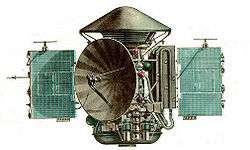Mars 5
| Mission type | Mars orbiter[1] |
|---|---|
| Operator | Lavochkin |
| COSPAR ID | 1973-049A[2] |
| SATCAT № | 6754[2] |
| Spacecraft properties | |
| Spacecraft | 3MS No.53S |
| Manufacturer | Lavochkin |
| Start of mission | |
| Launch date | 25 July 1973, 18:55:48 UTC[3] |
| Rocket | Proton-K/D |
| Launch site | Baikonur 81/24 |
| End of mission | |
| Last contact | 28 February 1974 |
| Orbital parameters | |
| Reference system | Areocentric |
| Periareon | 1,760 kilometres (1,090 mi) |
| Apoareon | 32,586 kilometres (20,248 mi) |
| Inclination | 35.3 degrees |
| Epoch | 12 February 1974 |
| Mars orbiter | |
| Orbital insertion | 12 February 1974, 15:45 UTC[2] |
Mars 5 (Russian: Марс-5), also known as 3MS No.53S was a Soviet spacecraft launched to explore Mars. A 3MS spacecraft launched as part of the Mars programme, it successfully entered orbit around Mars in 1974. However, it failed a few days later.
Spacecraft
The Mars 5 spacecraft carried an array of instruments to study Mars. In addition to cameras, it was equipped with a radio telescope, an IR radiometer, multiple photometers, polarimeters, a magnetometer, plasma traps, an electrostatic analyser, a gamma-ray spectrometer, and a radio probe.[4]
Built by Lavochkin, Mars 5 was the second of two 3MS spacecraft launched to Mars in 1973, following Mars 4. A 3MS was also launched during the 1971 launch window as Kosmos 419. However, due to a launch failure, it failed to depart Earth orbit. In addition to the orbiters, two 3MP lander missions, Mars 6 and Mars 7, were launched during the 1973 window.
Launch
Mars 5 was launched by a Proton-K carrier rocket with a Blok D upper stage, flying from Baikonur Cosmodrome Site 81/24.[3] The launch occurred at 18:55:48 UTC on 25 July 1973, with the first three stages placing the spacecraft and upper stage into a low Earth parking orbit before the Blok D fired to propel Mars 5 into heliocentric orbit bound for Mars.
The spacecraft performed course correction manoeuvres on 3 August 1973 and 2 February 1974, before reaching Mars on 12 February. At 14:44:25 the spacecraft's engines ignited to begin its orbit insertion burn, which successfully placed it into an Areocentric orbit with a periapsis of 1,760 kilometres (1,090 mi), an apoapsis of 32,586 kilometres (20,248 mi), and 35.3 degrees inclination.[2][4]
The spacecraft's pressurised instrument compartment began to leak as soon as the spacecraft entered orbit around Mars, which controllers believed to be the result of a micrometeoroid impact during orbital insertion. It ceased operations on 28 February, having returned 180 photographic frames, 43 of which were of usable quality.[4]
See also
References
- ↑ Krebs, Gunter. "Interplanetary Probes". Gunter's Space Page. Retrieved 12 April 2013.
- 1 2 3 4 "Mars 5". US National Space Science Data Centre. Retrieved 12 April 2013.
- 1 2 McDowell, Jonathan. "Launch Log". Jonathan's Space Page. Retrieved 12 April 2013.
- 1 2 3 Siddiqi, Asif A. (2002). "1973". Deep Space Chronicle: A Chronology of Deep Space and Planetary Probes 1958-2000 (PDF). Monographs in Aerospace History, No. 24. NASA History Office. pp. 101–106.


.jpg)
.jpg)